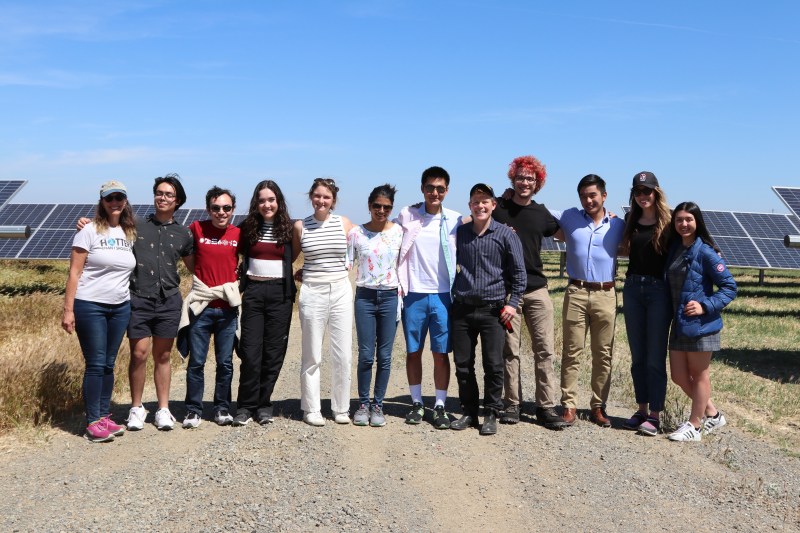Students from the Explore Energy Seminar, the Understand Energy class and residents from the Explore Energy theme house visited the Lemoore Solar Farm on Friday to tour the heart of the University’s source of clean energy.
A four-hour bus drive south of campus to Lemoore, Calif. in Central Valley lies the Stanford Solar Generating Station #2. The 2,400 acre expanse of solar panels, inverters and batteries that compose Stanford’s primary source of clean energy is part of the larger Slate project that began operations in March of 2022. The power plant utilizes approximately 1 million bifacial solar panels manufactured by Canadian Solar.
“We saw a new, massive solar complex co-located with battery storage. To say this is rare to come by would be a gross understatement,” Kevin Liang M.S. ‘23 said about this unique opportunity to visit the solar farm.
So how does the solar farm actually contribute to Stanford’s electricity usage?
To reach the proclaimed 100% renewable electricity consumption, Stanford’s solar farm must generate an equivalent or greater amount of electricity than the University’s annual energy consumption. Renewable energy certificates are used to account for renewable electricity generated at the solar farm.
“We track every kilowatt hour [of energy] that’s produced and push it back onto the grid,” said Craig Szot, business developer at MN8 Energy. “Once you hit 1,000 kilowatt hours, it generates one renewable energy certificate.”
Renewable energy certificates allow Stanford to account for the source of its electricity usage. When Stanford purchases 1,000 kilowatt hours of electricity in addition to one renewable energy certificate, the University can offset 1,000 kilowatt hours of electricity usage on campus with renewable energy sources.
“Stanford’s commitment as one of the offtakers of renewable energy from our Slate facility and purchaser of Renewable Energy Certificates allowed the building of this project,” added Rick Bielen, portfolio management lead for MN8 Energy, in a later comment. “Providing clean energy to the California grid offsets the local energy consumption and relative carbon emissions from Stanford University’s campus”
Once onsite, the students met representatives from the three main teams involved in the solar farm: Kings County local government, MN8 Energy and Canadian Solar.
The solar farm lies within Kings County, Calif., whose number one priority is agriculture, according to district 1 supervisor of Kings County Joe Neves. However, the agricultural prosperity of the lands in Lemoore is being challenged by two recent developments — the Sustainable Groundwater Management Act and the excess of salt in the soil.
“There was going to be some amount of land retirement to match the amount of water that was available for production agriculture,” Neves said. “That’s what brought us into solar generation. [The solar farm] gives this property a second chance to remain productive.”
Noelle Tomlinson, the Kings County planner, briefed the students about the solar farm contract specifics and the land it was built upon.
“These soils have too much salt in them in order for most crops to grow,” Tomlinson said, “Most of this land has always been grazing land.”
She mentioned that one of the agreements prior to issuing building permits for the solar farm was an agricultural management plan, which details that dry-farm sheep grazing supplements the operation of the solar power plant.
Bielen explained how they implement the plan for sheep grazing. “We use sheep when possible to maintain the vegetation instead of using gas powered lawn mowers or other herbicides,” Bielen said. “We have about 1,200 sheep on site right now.”
MN8 Energy is the owner and asset manager of the solar farm. According to Bielen, Canadian Solar’s bifacial panels on the farm produce approximately 300 megawatts, which reflects a 20% increase from monofacial panels, as these can absorb sunlight on both sides instead of just one.
Canadian Solar is responsible for the day-to-day monitoring and preventative maintenance of the solar farm, according to Jeremy McKellep, regional operations and maintenance manager at Canadian Solar. As the group toured the battery energy storage system, McKellep explained how overall electricity generation is measured when accounting for generation and storage.
“On the battery side, you have DC basically being turned into AC here in these inverters,” McKellep said. “It’s very similar for the solar panels, which produce DC input to the inverters. Now, how do the electrons move then? The panels and batteries share a common bus [connection] at the substations.”
An electricity meter at the common bus connection measures the electricity produced by solar panels, the electricity taken to charge the batteries and finally the electricity sent to the power grid, McKellep explained.
However, the solar farm’s renewable electricity doesn’t directly feed into Stanford’s energy system.
“In terms of the actual electrons, they’re feeding onto the grid here [in Lemoore],” said program manager for Explore Energy Wahila Wilkie.
At Stanford, electricity likely comes from nearer energy sources and not necessarily from the solar farm, according to Wilkie. Renewable energy certificates account for the balance between electricity generation at the solar farm and electricity consumption on campus.
Students took away a greater understanding of the solar farm and were inspired by Stanford’s efforts to transition to fully renewable energy.
“It was a trip of a lifetime,” Christopher Noll ‘23 said. “I hope future students can also have this exceptional educational experience.”
“[Stanford’s solar farm] can also help spur more innovation with solar panels and renewable technologies,” Brennan Lieu ’25 said.
Holmes Hummel, the resident fellow of the Explore Energy House, helped organize the field trip.
“Explore Energy House is an extraordinary base camp for adventures in the energy revolutions already underway, so it is gratifying to open Stanford’s own investments [in renewable energy] to residents,” Hummel said.
The Daily updated this article to include a quote from Bielen which clarified the role of renewable energy certificates for reducing emissions from electricity for Stanford’s campus.
This article has been updated to accurately reflect the role in which the solar farm plays in offsetting the University’s electricity use. The Daily regrets this error.
